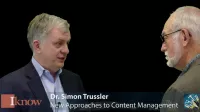In some ways, we are living in a golden age for knowledge management, with the explosion of new sources of data and information creating enormous opportunities for organizational learning. Internal document repositories and external news sources continue to proliferate, augmented by social media, image-based content, and other sources of “big data”.
At the same time, however, we are outstripping our capability to extract useful knowledge from this flood of new content using traditional KM approaches, and easier document capture makes the problem worse. With boomer retirements, job churn among millennials, and greater time pressure on everyone, there are significant constraints on human-driven content collection and curation models.
Given these pressures, it’s more important than ever to have a tightly focused KM content strategy; a clear idea of which topic areas and which types of content will help people do their jobs better and will create the biggest business impact. Once these goals are in place, attention can shift to the most effective ways to gather and manage this content on an ongoing basis.
This is where new tools can be very helpful. Let’s look at four areas of current innovation with the potential to “turbo-charge” traditional KM content management.
- Enhancing situational awareness. As the number and velocity of data and information sources increases, we need more help digesting and evaluating them, combining the results with insights from internal content, and understanding the implications. New tools are beginning to address these challenges using high precision text and semantic analysis, combined with business intelligence for effective presentation and internal communication. Features include exploratory search of incoming content streams as well as event-driven information delivery, based on business rules about relevant opportunities and threats, e.g. new or existing competitors, emerging customer requirements, or supplier activity. These innovations hold great promise for improving organizations’ environmental scanning, agility, and responsiveness.
- Building automated content intelligence. To support improved information analysis and delivery, we need faster and more accurate identification of the facts, topics, and themes embedded in unstructured text. Content intelligence solutions use automated categorization to make sense of these enormous volumes of information and allow users to search and navigate through it. When this knowledge is harnessed into a comprehensive taxonomy, including cross-topic relationships, it becomes exponentially more useful; yielding insights that can be put together with structured data to solve business problems and generate appropriate workflows. For example, knowledge about car repairs extracted from technician’s logs can be combined with location and environmental data to pinpoint emerging reliability issues and solutions. Or sensitive content in document libraries can be automatically detected and routed into special repositories for audit and regulatory purposes.
- Capture and codification of tacit knowledge. The retirement bulge, combined with increased turnover of junior staff, creates a critical need to capture the latent expertise of long-tenured employees, so that organizational learning does not evaporate with each passing year. Many organizations use exit interviews to gather this know-how, but the most specific, operational content requires a stronger organizing framework: which business processes does it address, under what circumstances, and with what implications? New decision-analysis tools can help significantly with this by capturing tacit knowledge about any business process in terms of “if-then” scenarios and implications, using rules and logic provided by subject matter experts. This approach has been successfully used in public-sector benefits evaluation settings, where complex eligibility rules need to be combined with the know-how of experienced caseworkers to make the right decisions and provide the best customer service.
- Leveraging digital assets. The explosion of rich media digital assets (e.g., video, audio, images, design files) creates numerous issues and challenges for organizations, including storage of large files, rights management and workflows, and integration with traditional document-based KM platforms. New digital asset management (DAM) systems can address these needs and enable organizations to store, catalogue, search, and deliver digital assets alongside text-based content. The combination of these different types of knowledge asset can significantly enrich traditional document based KM systems and lessons learned repositories, using video, audio and images to reinforce the written word and provide a much more engaging experience for users. The latest DAM systems provide highly scalable storage, permissioning, metadata and publishing tools to support these initiatives, delivering huge benefits in terms of cost and time savings, risk reduction, and optimal usage of these critical assets.
The innovations and benefits described above are ultimately aimed at stimulating the use of knowledge resources throughout the organization, in the service of greater business agility, efficiency, and growth. For end-users of knowledge, these tools offer the potential for expanded and enriched access to content and insights, as well as easier navigation among related ideas. For knowledge managers, they provide new and more scalable ways to codify, organize, and analyze content in the service of enterprise goals.


